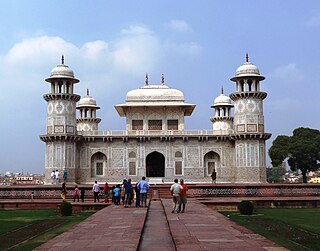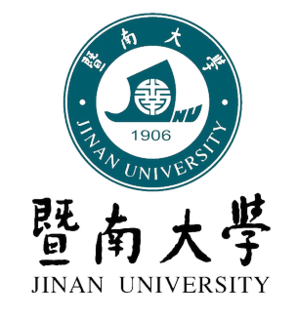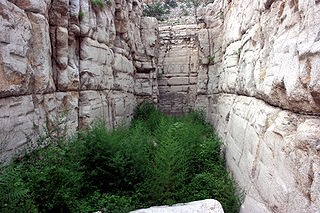
A tomb is a repository for the remains of the dead. It is generally any structurally enclosed interment space or burial chamber, of varying sizes.

Kaifeng, known previously by several names, is a prefecture-level city in east-central Henan province, China. It is one of the Eight Ancient Capitals of China, for being the capital seven times in history, and is most famous for being the capital of China in the Northern Song dynasty.

Jinan, formerly romanized as Tsinan, is the capital of Shandong province in Eastern China. The area of present-day Jinan has played an important role in the history of the region from the earliest beginnings of civilization and has evolved into a major national administrative, economic, and transportation hub. The city has held sub-provincial administrative status since 1994. Jinan is often called the "Spring City" for its famous 72 artesian springs.
Its population was 6.8 million at the 2010 census.

Jinan University is a public research and comprehensive university based in Tianhe District, Guangzhou city, Guangdong province, China. It is one of the oldest universities established on China tracing back to the Qing dynasty (1644–1911).

Goguryeo tombs, officially known as the Complex of Koguryo Tombs, are tombs in North Korea. In July 2004, they became the first UNESCO World Heritage site in the country. The site consists of 30 individual tombs from the later Goguryeo kingdom, one of Three Kingdoms of Korea, located in the cities of P'yŏngyang and Namp'o. Goguryeo was one of the strongest Korean kingdoms in northeastern China and the Korean Peninsula from 37 BCE to the 7th century CE. The kingdom was founded in the present day area of North Korea, and part of Manchuria around 37 BCE, and the capital was transferred to P'yŏngyang in 427 CE.

Cihu Mausoleum, officially known as the Mausoleum of Late President Chiang or President Chiang Kai-shek Mausoleum is the temporary resting place of President Chiang Kai-shek. It is located in Daxi District, Taoyuan City, Taiwan. When Chiang Kai-shek died in 1975, he was not buried in the traditional Chinese fashion but entombed in a black marble sarcophagus since he expressed the wish to be eventually buried in his native Fenghua in Zhejiang province once the Kuomintang (KMT) recovered mainland China from the Communists.
Shandong Airlines Co,.Ltd. is an airline based in the Shandong Airlines Center in Jinan, Shandong. The Chinese carrier operates a sizable domestic network from Jinan, Qingdao and Yantai to major cities across China, together with an international network to regional Asian destinations. The airline's two largest shareholders are Shandong Aviation Group with a 42% controlling stake and Air China, a strategic partner, holding 22.8% of the airlines shares.

A jade burial suit is a ceremonial suit made of pieces of jade in which royal members in Han dynasty China were buried.

Daming Lake (Chinese: 大明湖; pinyin: Dà Míng Hú; Wade–Giles: Ta4 Ming2 Hu2; literally: 'Lake of the Great Splendour') is the largest lake in the city of Jinan, Shandong, China and one of city's main natural and cultural landmarks. Located to the north of the historical city center, the lake is fed by the artesian karst springs of the area and hence retains a fairly constant water level through the entire year.

The Dragon-and-Tiger Pagoda is a Tang Dynasty brick and stone pagoda located in central Shandong Province, China. It is considered a characteristic example of the pagoda style of the period.

The Qianling Mausoleum is a Tang dynasty (618–907) tomb site located in Qian County, Shaanxi province, China, and is 85 km (53 mi) northwest from Xi'an, formerly the Tang capital. Built by 684, the tombs of the mausoleum complex house the remains of various members of the House of Li, the imperial family of the Tang dynasty. This includes Emperor Gaozong, as well as his wife, Wu Zetian, who usurped the Tang throne and became China's only reigning female emperor from 690–705. The mausoleum is renowned for its many Tang dynasty stone statues located above ground and the mural paintings adorning the subterranean walls of the tombs. Besides the main tumulus mound and underground tomb of Emperor Gaozong and Wu Zetian, there are 17 smaller attendant tombs or peizang mu. Presently, only five of these attendant tombs have been excavated by archaeologists, three belonging to members of the imperial family, one to a chancellor, and the other to a general of the left guard. The Shaanxi Administration of Cultural Heritage declared in 2012 that no further excavations would take place for at least 50 years.

The Tomb of the Jibei King is a tomb from the time of the Western Han Dynasty in Changqing District of Jinan, Shandong Province, China. It is also known as the Han Dynasty Tomb of Shuangru Mountain. The tomb is thought to have been the burial site of Liu Kuan, the last king of Jibei who ruled from 97–85BC during the time of the Emperor Wu of Han of the Western Han Dynasty. The tomb was a major archaeological find since it had been untouched by grave robbers. Its discovery was ranked among the top ten Chinese archaeological finds of 1996 by Chinese National Office for Cultural Artefacts.
China Railway Jinan Group, officially abbreviated as CR Jinan or CR-Jinan, formerly, Jinan Railway Administration is a subsidiaries company under the jurisdiction of the China Railway. It supervises the railway network within Shandong Province. It is in charge of the railway with total length of 8,283.9 kilometers, and consists of 295 railway stations. The railway administration was reorganized as a company on November 2017.

The Eastern Qing tombs are an imperial mausoleum complex of the Qing dynasty located in Zunhua, 125 kilometres (78 mi) northeast of Beijing. They are the largest, most complete, and best preserved extant mausoleum complex in China. Altogether, five emperors, 15 empresses, 136 imperial concubines, three princes, and two princesses of the Qing dynasty are buried here. Surrounded by Changrui Mountain, Jinxing Mountain, Huanghua Mountain, and Yingfei Daoyang Mountain, the tomb complex stretches over a total area of 80 square kilometres (31 sq mi).

Que Hill is a small elongated hill located on the western shore of the Yellow River in the City of Jinan, Shandong Province, China. It is one of the solitary "Nine Hills" in the Yellow River valley within and to the north of Jinan City. Together with Hua Hill, which is today located on the opposite side of the Yellow River, Que Hill is depicted in a renowned painting by the Yuan-Dynasty era painter and calligrapher Zhao Mengfu entitled "Autumn Colors at Que and Hua Hills". The hill is positioned close to the northern end of the Luokou Yellow River Railway Bridge which was placed there because the hill stabilizes the course of the Yellow River. In November 1937, Japanese troops attacked the northern shore of the Yellow River and killed about 50 villagers who lived around Que Hill, the event became known as the Que Hill Tragedy.

The Tomb of Min Ziqian is a memorial to Min Sun, a disciple of Confucius and the fourth of the 24 Confucian paragons of filial piety. The memorial is located in Jinan, the capital of Shandong Province, China.

The Tomb of Zhang Yanghao also known as the Grave of Lord Zhang is a monument to the Yuan-Dynasty Sanqu poet Zhang Yanghao. It is located in a public park in Liu Yun Village (柳云村) within the urban area of Tianqiao District in the city of Jinan, Shandong, China.

Liu Wu (刘武)(c. 184–144 BC), posthumously named Prince Xiao of Liang, was a Han prince. He was a son of Emperor Wen and Empress Xiaowen, and a younger brother of Emperor Jing. He played a prominent role in the suppression of the Rebellion of the Seven Princes. He was also responsible for the assassination of the minister Yuan Ang.


















